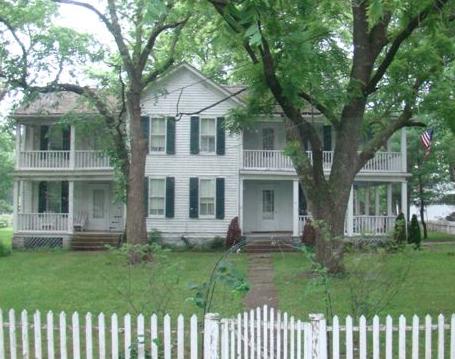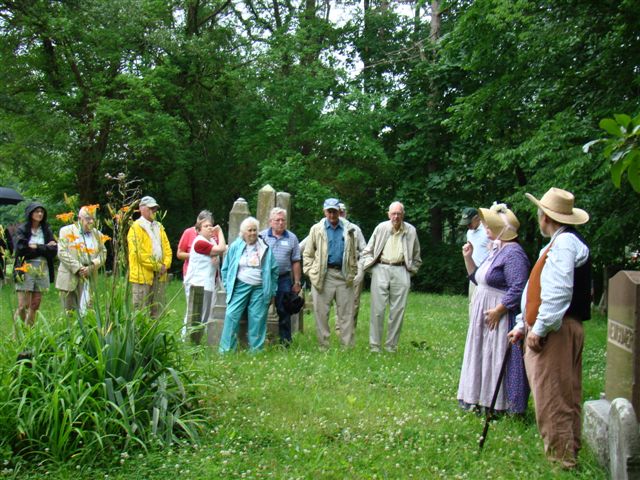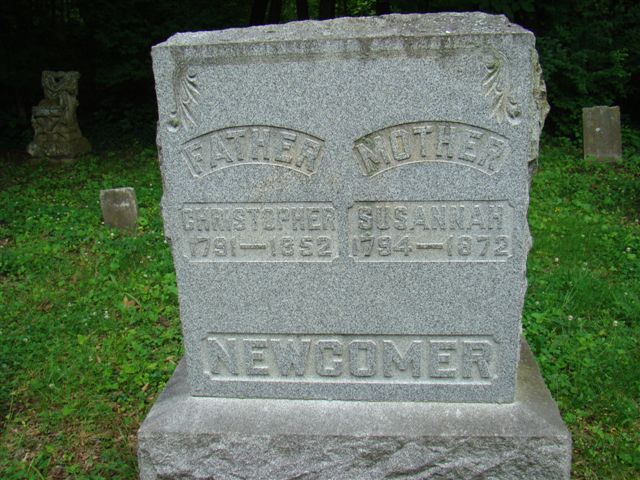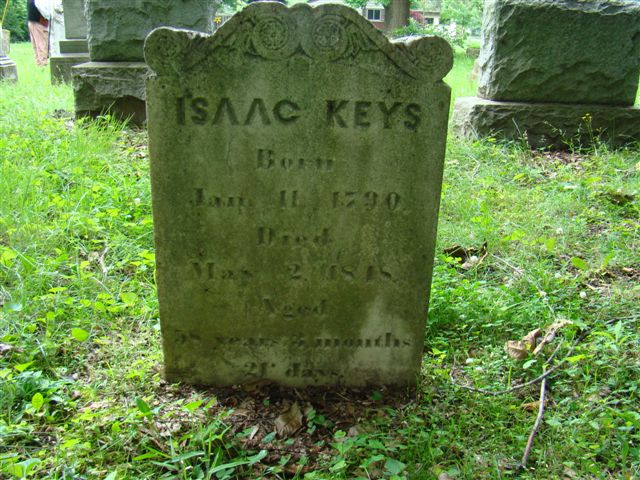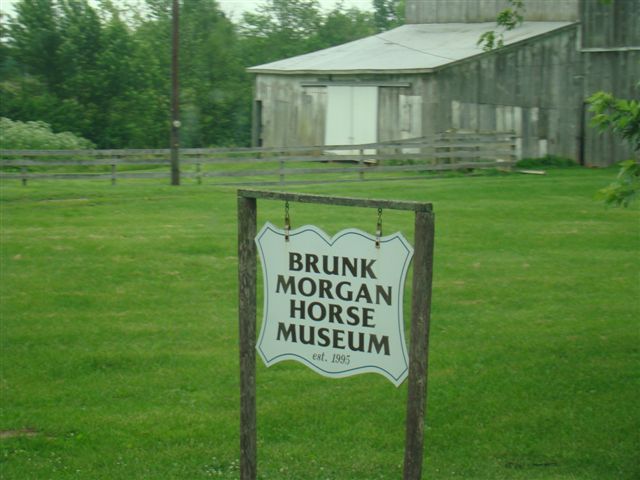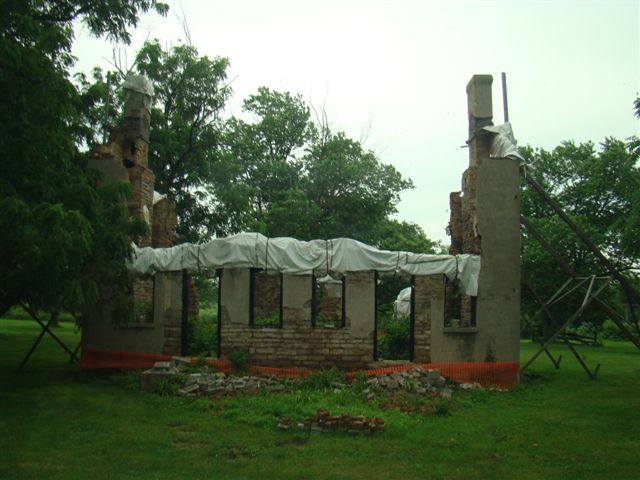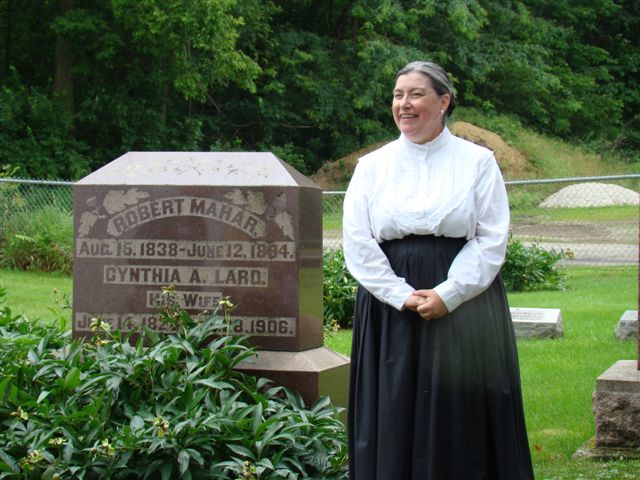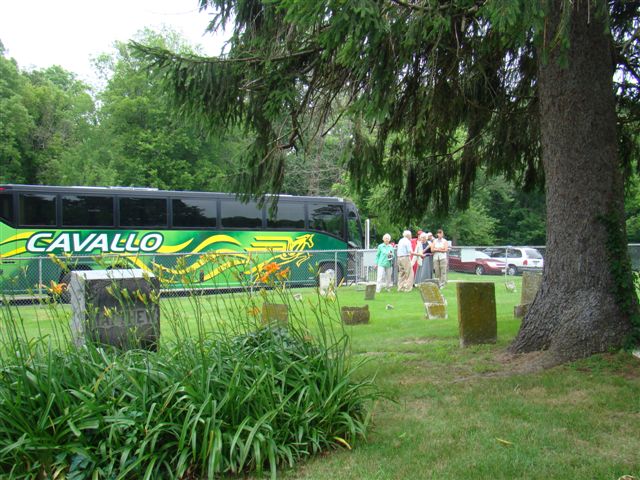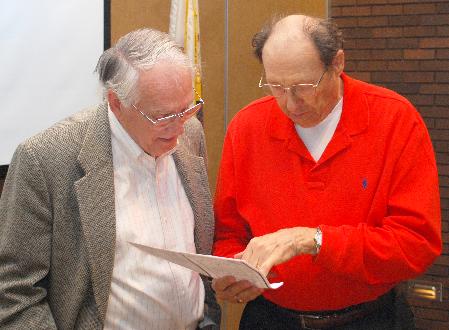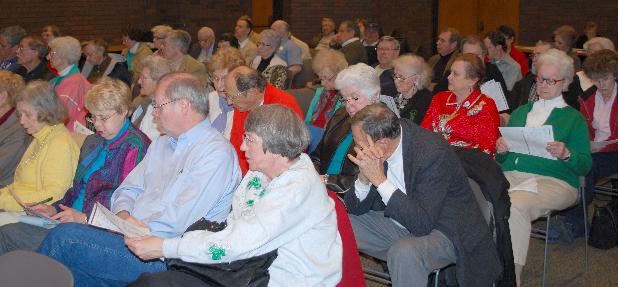
The June 2010 issue of the Historico is now online as a pdf.
|
Have a Sangamon County history question? |
(Posted June 28, 2010)
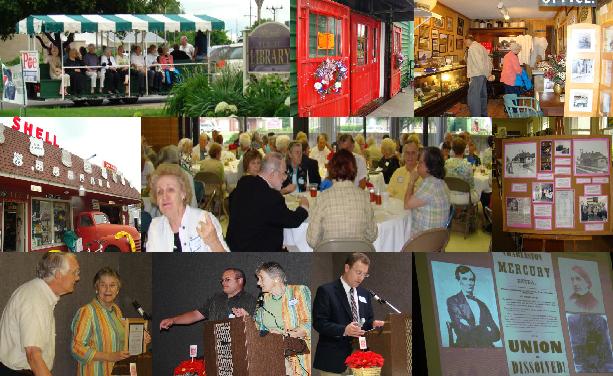
ANNUAL MEETING FARE: (From top, left: the tram
ride; entrance to the Box Car Museum; inside the Box Car Museum. Second row,
from left: the Route 66 gas station; dinner in the Municipal Building; part of
the Williamsville Library display. Bottom row, from left: Incoming President
David Scott presents a certificate of appreciation to immediate past president
Nancy Chapin; Curtis Mann, the Society's immediate past secretary-historian and
a past president joins Chapin at the podium as the evening's fundraiser host;
guest speaker Tim Townsend and one of the graphics he used in is talk on
Lincoln. Photos by Donna Catlin.
Capacity Crowd Turns Out For Annual Meeting, Tour of Williamsville, Elections
Heavy afternoon rain that moved east across the
Springfield area toward Decatur didn't dampen the enthusiasm of Society members
and the guests who slipped passed the worst of the weather and headed to
Williamsville on Tuesday, June 15 for a round of late afternoon activities prior
to the start of the Society's annual meeting. Light showers had already past as
dozens of participants hopped aboard a tram provided by State representative Ray
Poe for a tour of Williamville's historic homes and sites while others toured
the community's Box Car Museum, its Route 66 era gas station and exhibits at the
Williamsville Public Library, all within walking distance of the Williamsville
Municipal Building/Community Center where the annual dinner was held. The events
began at 5 p.m., the dinner at 6 p.m.
Keynote speaker Tim Townsend, historian at the Lincoln Home National Historic Site in
Springfield and a nationally known authority on Lincoln, provided dinner-goers
with insight into the period just prior to and immediately after the election of
Lincoln, using slides to illustrate both the public and private reaction to his
political success as it played out in Springfield. Townsend served as president of the Society from 1999 to 2000.
Other highlights of the evening included a presentation by David Scott of a
framed certificate acknowledging the efforts and accomplishments of Nancy L.
Chapin who was completing her two-year term as president of the Society. Scott,
the incoming president, headed a slate of officers for 2010-2011 that was
unanimously elected at the meeting. In addition to Scott, other officers are vice-president Vicki
Megginson; secretary Pam VanAlstine, and incumbent treasurer Paul R. Mueller.
Elected to three-year terms on the board with terms expiring in 2013 were Linda Bee,
Bruce Beeman, Claire Eberle, Carolyn Oxtoby and Jane Tredwell. Carolyn
Moore elected to fill the two years remaining on Megginson’s board
position which expires in 2012. In remarks following his election, Scott cited
the board's effort to develop a long range plan for the organization in an
effort to define its future goals and expand membership.
Several lucky ticket holders left the
dinner with prizes of their choice from a group of more than 20 items donated to
the Society for a fundraiser that has become a traditional part of the annual
meeting. Among the historical-themed choices were tickets to shows at Sangamon
Auditorium and Theatre in the Park, a glass compote dish from the Freeman-Hughes
House, autographed books, antique dessert plates, works of art including pottery
and framed mixed-media renderings of local historical sites, a personal tour of
Iles House, tickets to Lincoln's Ghost Walk, and a professional appraisal of
historical books.
( posted June 14, 2010)
Elkhart Historical Society Readies Lincoln Themed Events for July 16 and 17
The Elkhart
Historical Society will hold a full weekend of Lincoln-related events in July
ranging from lectures to a sale of Lincoln items at a local book shop. Most
events require pre-registration. Forms are available at the Society's website, www.elkharthistoricalsociety.org.
Lincoln’s lifestyle as a
judicial circuit lawyer will be the topic of a Friday, July 16 talk by Bob
McCue, a member of the State Historical Society, Elkhart Historical Society, and
a regular tour guide for Lincoln and Elkhart Hill. He is a historical re-enactor
and guide at the Abraham Lincoln Neighborhood in Springfield and a tour guide at
the Mt. Pulaski 8th Judicial Circuit Courthouse in Lincoln.
McCue will be joined by his
brother, Chuck McCue, who will discuss the "DAR 8th Judicial Circuit
Markers." Using the research of Lincoln scholar Guy Fraker of Bloomington
and with the help of his wife and brother, Chuck has located the remaining
markers along the 400 miles of the circuit and is actively working with the
Daughters of the American Revolution to promote the preservation and possible
restoration of these monuments.
The dinner lecture will be held at The Wild Hare Cafe,
104 Governor Oglesby Street, Elkhart. Dinner begins at 5:30 p.m., with the talks
from starting at 7 p.m. Reservations and pre-payment are required, and space is
limited. Cost is $17.99. The dinner package price includes the meal, dessert,
drink, tax and gratuity. Reservations must be in by Monday, July 12.
The dinner will be followed on Saturday, July 17, with
two tours of historic Elkhart Hill and two tours of the chapel in the Elkhart
Cemetery. The tours will be offered at 9:30 a.m. and 1:30 p.m. For the
Historical Elkhart Hill tour, participants will be riding in the Elkhart
Historical Society’s tour wagon. The tour includes Indian, pioneer,
historical, and political sites. A stop is planned at the "Looking for
Lincoln Wayside Exhibit" located near the Elkhart cemetery. This exhibit
covers the Lincoln connection with Illinois Governor Richard J. Oglesby, who is
buried in the cemetery. Reservations are required for all tours. Each outing
will last approximately 90 minutes, and tours are limited to 16 people. The cost
is $10 for adults, $7.50 for seniors (60 and over), and $5 for children (12 and
under). Registration closes on July 12.
In addition, tours of the
historic St. John the Baptist Chapel on Elkhart Hill will be offered at 9:30
a.m. and 1:30 p.m. The Episcopalian Chapel was built in 1890 and is the only
privately owned and operated church in Illinois. Constructed by the Culver Stone
and Marble Company of Springfield, it is one of the few remaining Culver
buildings in the area. Designed in Gothic Revival style, it houses one of the
three oldest working pipe organs in the state (built by Hook and Hasting Company
out of Boston). The tour includes a demonstration played on the organ. Beautiful
Tiffany-style stained-glass windows grace the interior of this historic chapel.
The tour will begin at the chapel. Reservations are not required but are
recommended. The cost is $10 for adults, $7.50 for seniors (60 and over), and $5
for children (12 and under).
A special recital on the chapel organ is scheduled for
4 to 5 p.m. on Saturday, July 17. Organist Marcy Brooks, formerly from
Broadwell and currently residing in Liberty, Kentucky, will play the historic
organ. The recital is by reservation only and space is limited. A tour of the
chapel is not included in the recital. The cost is $5 per person. As with the
other events, a printable reservation form can be downloaded from the Elkhart
Historical Society website.
Among the other activities
tied to the weekend will be a special display of Lincoln resources at the
Elkhart Library and the sale of Lincoln items at Birdsong Books and Vintage Shop
in Elkhart.
The Elkhart
Historical Society plans to continue its lecture series in the fall, with a
presentation on September
September 24 on family history and genealogy and on October 15 on the geology of
Elkhart Hill. Future tours in Elkhart for 2010 include Historical Hill Tours on
September 25, and a new tour experience, "Elkhart - Little Village, Big
Stories" (a tour wagon ride through the village with humorous
folklore about Elkhart's people, places and things) on Saturday, October 16.
---PAST POSTINGS....PAST POSTINGS....PAST POSTINGS....PAST POSTINGS....PAST POSTINGS....
(posted June 14, 2010)
HISTORY TOUR GOERS saw (from upper left), the Alexander J. Jones House, headstones for Christopher and Susannah Newcomer and Isaac Keys, the George Brunk Horse Farm and the remains of the Brunk Home that was destroyed by fire in 2005, and scenes from the Philemon Stout Cemetery stop where costumed actors like Linda Schneider (above, left) portrayed some of the early settlers.
A
Trip Back In Time to Sangamon County's First Settlement
(Society
Board member Donna Catlin was among those on a jointly sponsored Sangamon County
Historical Society-Elijah Iles House Foundation bus tour of the Sugar
Creek/Cotton Hill area on June 5. Catlin snapped all the photos and provides
some commentary on what the tour-goers saw and learned of a location south of
Springfield that
was home to the area’s earliest settlements).
By
Donna Catlin
When Robert Pulliam came to this area in October, 1817, it was rich with
buffalo, groves of sugar maples and an Indian trail known as Edwards Trace.
Over the years as this location became more populated, this part of
Sangamon County grew into a lovely scenic jewel which today covers an area in
and around Lake Springfield.
The families who settled in Cotton Hill Precinct were people who migrated
from various parts of the country. These
settlers arrived here after traveling great distances to begin their new lives.
They were hard working, lived through many hardships and survived all the
while creating local family roots for generations to come. On
the tour we met descendants of some of these early settlers.
Dick Hart was the tour guide, sharing his great knowledge of this area of
Sangamon County. He and Society
president Nancy Chapin expanded our historical knowledge as we passed sites that
some of us have never seen. They brought to life the history of many early
settlers and their families with names like Zachariah and Nancy Spaulding Peter,
William Drennan, John Kelly, Alexander J. Jones, Philemon Stout, Megredy, Hermon,
Laughlin, Renn, White, Woozley, Wills, Joshua W. Jones, Jonathan Bozarth
Peddicord, Minerva Barnard, Robert and Tabitha Lard Jones, Penelope Anderson
Stout, Mahar, Melissa Shoup Stout, Col. Samuel N. Shoup, Dr. Alexander Shields,
Elizah Slater, Elijah and Delilah Shoup Bradshaw, David and Maria Shoup Brunk,
Jacob Shoup, George Brunk, Nicholas Vachel Lindsay, David and Rosanna Ebey Beam,
Christopher and Susannah Sells Newcomer, Mr. Carman, and Isaac Hess Keys.
We also were fortunate to have R. Lou Barker, Elizabeth Currie
Lovegrove and others share personal stories of their ancestors. Elizabeth
Lovegrove, a descendent of Alexander J. Jones, lives in the house he built. A
nearby barn that he built still stands today.
Alexander J. Jones was born in 1786 in Orange County, North Carolina and
eventually ended up migrating to Cotton Hill Precinct with many members of the
Jones family.
Robert W. Jones died September 26, 1833 and is the earliest grave in the
Sugar Creek Cemetery (aka. Jones and McGredy Cemetery). While visiting this
cemetery, Dick Hart shared stories
with us that Philemon Stout, Jr. had written about the cemetery in his diary in
1874.
On Stout Drive off of East Lake Shore Drive, we saw a stone marker in the
backyard of a descendant of Philemon Stout, Sr. This
stone was erected in honor of Philemon and Penelope Stout.
The Stouts at one time lived with the Jones family.
At the Philemon Stout Cemetery, we were greeted by descendants of the
Stout family. In addition, actors Linda and Don Schneider treated us to real
life portrayals of Charles Calvin Lafayette Jones (1859-1949) and Cynthia Ann
Lard Mahar (circa 1833-1906).
We also visited the George (Joe) Brunk cemetery established in 1829;
Vigal established in 1835; and the David Brunk Cemetery in 1855.
Another highlight of our tour was our stop at the Christopher Newcomer
Cemetery which was established in the fall of 1845 as the result of a family
tragedy. We learned that Christopher and Susannah Newcomer’s 20 year-old
daughter, Armenia, died on September 4, 1845. Six days later, their 19 year-old
daughter, Jane, died. Their parents located the cemetery so that it could be
viewed from their home.
At the Christopher Newcomer Cemetery, portraying Christopher and Susan
Newcomer, actors Don and Linda Schneider held a conversation as it might have
taken place around 1850. Other
Newcomer neighbors buried here are Isaac Keys and David Beam. David Beam from
Pensacola Tavern and Beam’s Mill is an ancestor of Springfield’s former
Judge Harvey Beam.
The George Brunk
House was built about 1824, but was destroyed by fire in 2005.
This was one of the first stone houses in Cotton Hill Precinct.
The house site and barn is now the Brunk Morgan Horse Museum.
This tour was a
success. Even a light rain at times did not dampen the enthusiasm of the crowd
attending this event.
(posted June 5, 2010)
Lincoln
Home Historian Timothy Townsend to Keynote Annual Dinner June 15;
Event to Include Tram Ride To See Williamsville's Historic Homes, Exhibits Too
A ticket to this year's Sangamon County Historical Society annual dinner
in Williamsville on Tuesday, June 15 will bring you more than a delicious
sit-down supper.
In addition to
getting some expert insight from nationally-known Lincoln historian Timothy
Townsend into a Presidential election that changed history 150 years ago and
voting for new directors and board members, you’ll have a chance to win some
sensational prizes including signed and framed limited edition mixed-media
artworks, tickets to Sangamon Auditorium and New Salem’s Theater in the Park,
appraisals of antique books, autographed copies of some popular history books,
antiques, Route 66 collectibles, tickets to Lincoln’s ghost walk, and more! 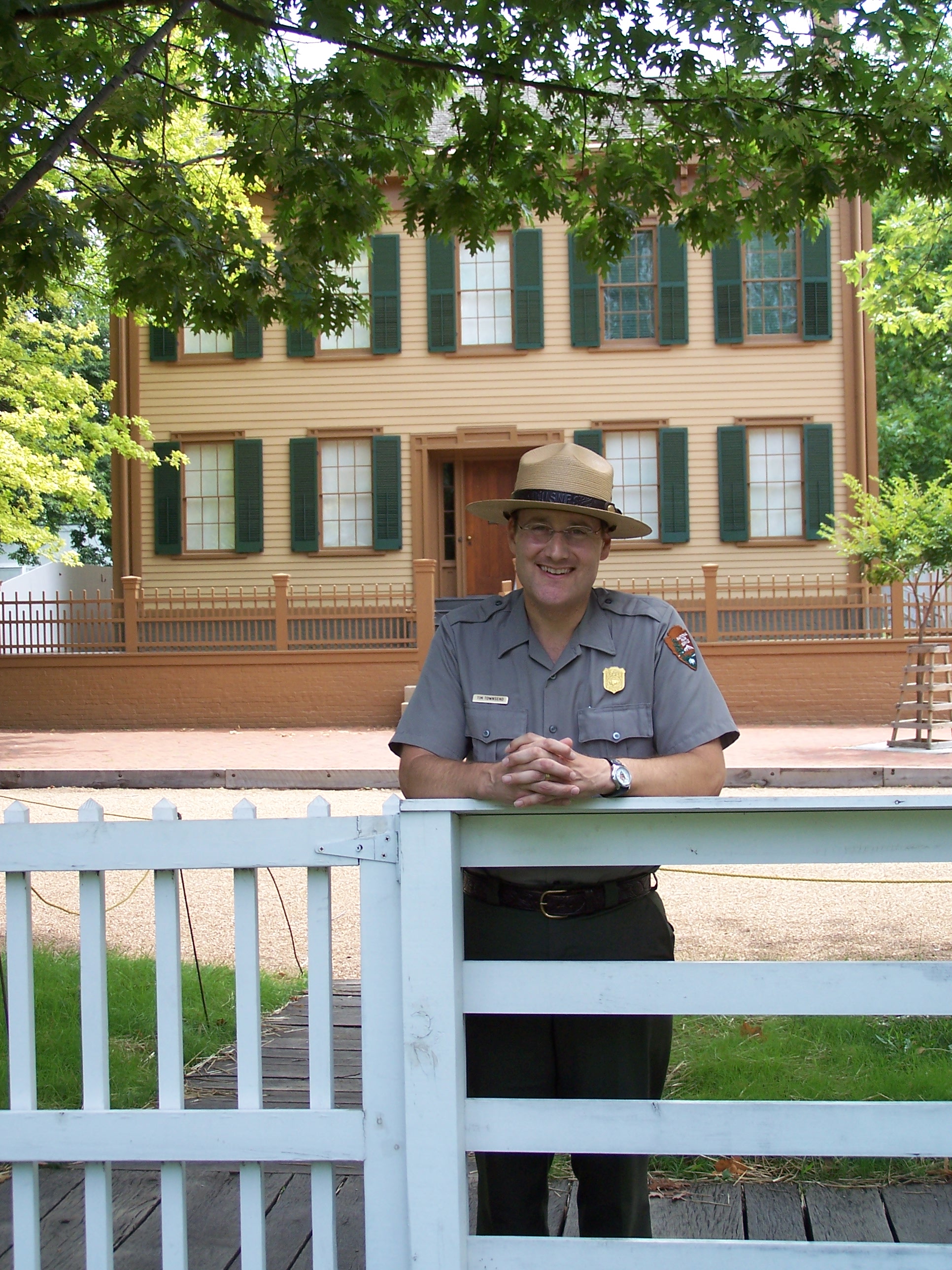
The fun, in fact,
begins even before the 6:30 p.m. dinner. Starting at 5 p.m., you can hop aboard
a tram for free guided 15 minute tour of Williamsville’s grand historic homes
and sites and then wander through the community’s famous Boxcar Museum filled
with local history and Route 66 memorabilia. The Williamsville Library, housed
in the former Williamsville railroad station just next door, will have some
special exhibits for you to see.
Across the street and down the block from the Williamsville Municipal
Building/Community Center (where the dinner will be held), you can check out the
nostalgic Route 66 gas station, complete with two digit per gallon price signs
that should bring back a flood of memories and tears to the eye.
At 6 p.m., the
cash bar will open, giving you time to mix and mingle and get an advanced look
at the many prizes that will be raffled off during the evening for benefit of
the Society. Raffle tickets will be $5.
Dinner tickets
are $20 per person for members, $25 for non-member. Call the Society at 522-2500
to check on ticket availability.
Townsend, (right) historian at the Lincoln Home National Historic Site in
Springfield, served as president of the Society from 1999 to 2000. He began his
career with the National Park Service in 1991 as a Lincoln Home Park Ranger. He
earned a bachelor of arts degree in from St. Ambrose University in Davenport,
Iowa, and holds a master of arts degree in history from the University of
Illinois at Springfield. Prior to his assignment at the Lincoln Home National
Historic Site, Townsend worked on the curatorial staff at the Rock Island
Arsenal Museum and was an interpreter at the U.S. Grant Home, the Vachel Lindsay
Home, and the Lincoln-Herndon Law Offices. He also assisted with field
archeology and research for the Springfield archeological firm of Fever River
Research.
Williamsville,
established in 1853, was originally known as Benton, but the name was changed in
1854 in honor of Colonel John Williams, a local landowner, after residents
petitioning for a post office in the community learned there was another Benton
in Illinois.
The downtown
flanks both sides of the railroad and was a stopping point along historic Route
66. Downtown Williamsville is located just east of I-55,
about nine miles north of Springfield at exit 109 (Illinois 23).
(posted June 5, 2010)
Society Members to Vote on Officers, Directors at June 15 Annual Meeting
Members attending the Society’s annual meeting on
June 15 in Williamsville, will be voting on a new officers and directors for the
coming year.
Nominated for three-year terms on the board with terms expiring in 2013 are Linda Bee, Bruce Beeman, Claire Eberle, Carolyn Oxtoby and Jane Tredwell.They will succeed R-Lou Barker, Elaine Birtch, Kim Effrid, Sue Wall and Martha Wolters whose terms also expire this month.
Carolyn Moore was nominated to fill the two years remaining on Megginson’s board position which expires in 2012.
(posted May 19, 2010)
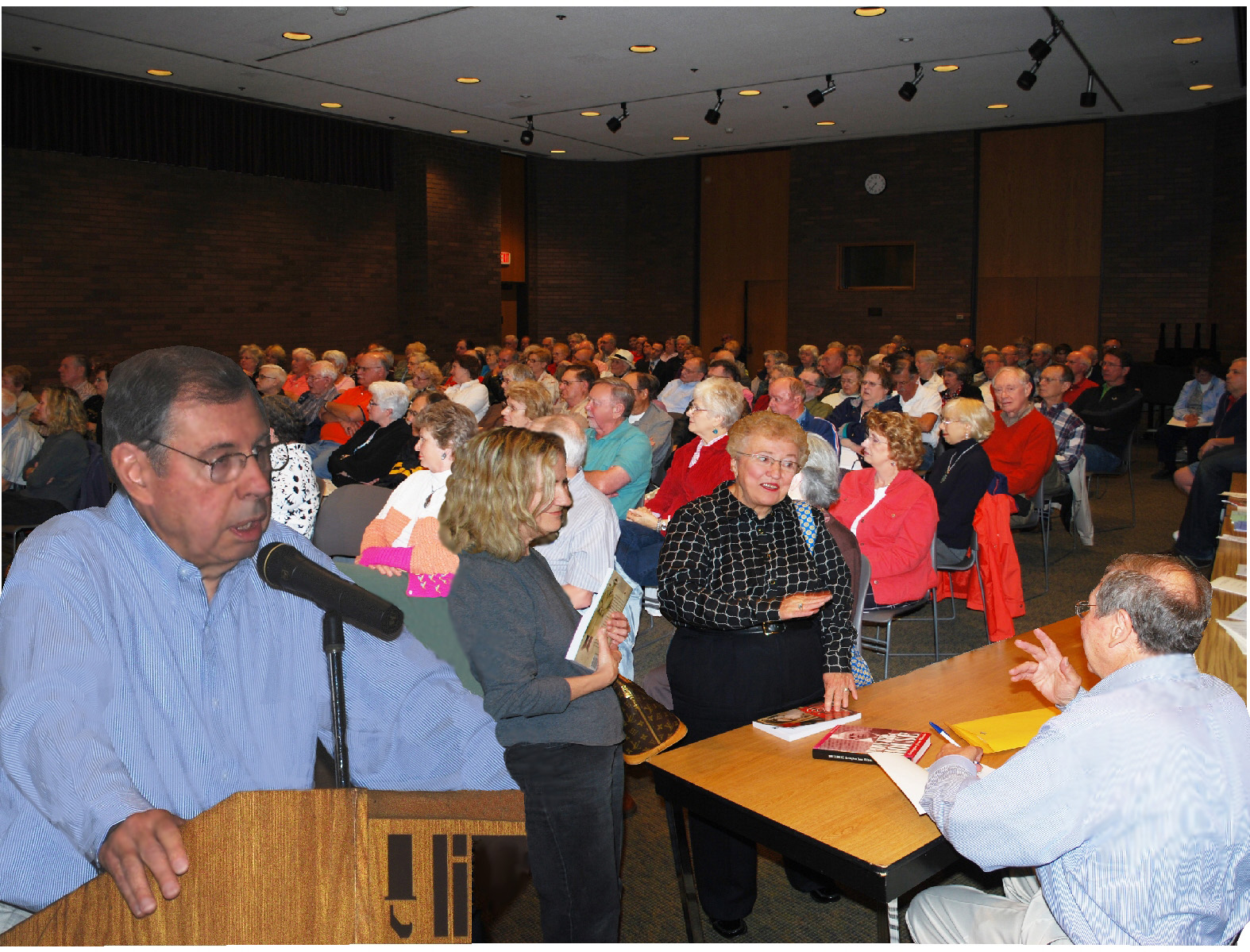
AUTHOR DRAWS FULL HOUSE: Former St. Louis Post-Dispatch Illinois political columnist and author Taylor Pensoneau (at podium, left) filled the Lincoln Library's Carnegie Room to the max in Springfield on Tuesday, May 18 when he spoke to the Sangamon County Historical Society about "Governors and Gangsters." Pensoneau, a former Society president, shared stories and insight into the criminals and politicians he has written about in a series of popular books including former Governors Dan Walker and Richard Ogilvie, the notorious Shelton Gang and most recently, Black Charlie Harris. Later he autographed books for fans (right). (composite photo)
(posted
May 19, 2010)
Tickets Still Available for June 5 Sugar Creek Bus Tour
Tickets are still available for a June 5 bus tour of the Cotton Hill District, Sangamon County’s birthplace. The area—in
and around Sugar Creek—was home to the first generation of settlers here. 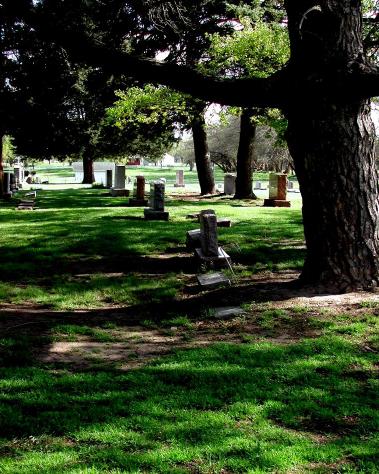 The tour is being co-sponsored by the Society and the Elijah Iles House Foundation
and is open to members of both organizations and the
general public.
The tour is being co-sponsored by the Society and the Elijah Iles House Foundation
and is open to members of both organizations and the
general public.
Traveling in a comfortable, air conditioned tour bus, trip takers will
hear stories and descriptions of Sangamon’s earliest settlement sites and view
over five 19th century farm houses and early family cemeteries. At two of the
cemeteries, actors will portray several of the early settles buried there.
The tour, expected to take about two-and-a half hours, will leave from
the Meijer’s parking lot off Veterans Parkway (Route 4), Springfield, at 1
p.m. Sites and history along the route of what used to be the south side of
Sugar Creek will be detailed by historian Dick Hart on the way down. He’ll do
the same for the north side of Sugar Creek on the way back.
The tour is the first of several activities in preparation for John Mack
Faragher’s visit to Springfield to help the Society celebrate its 50th
anniversary next April. Faragher, author of “Sugar
Creek: Life on the Illinois Prairie” (Yale
University Press), is the Arthur Unobskey Professor of American History at Yale.
Faragher teaches the history of the American West and directs Yale’s
Howard
R. Lamar Center for the Study of Frontiers and Borders.
(posted April 30, 2010)
Iles House Seeking More Docents For
Summer Tourist Season Ahead
More docents are needed at the historic Elijah Iles House in
Springfield to enable the house to be open longer during the summer tourist
season. Because of the layout of the
house, there must be two docents in attendance at all times the house is open.
Telling visitors about the house and its history is rewarding and fun.
If you think you would be interested in helping out, call Logan McMinn
679-0797.
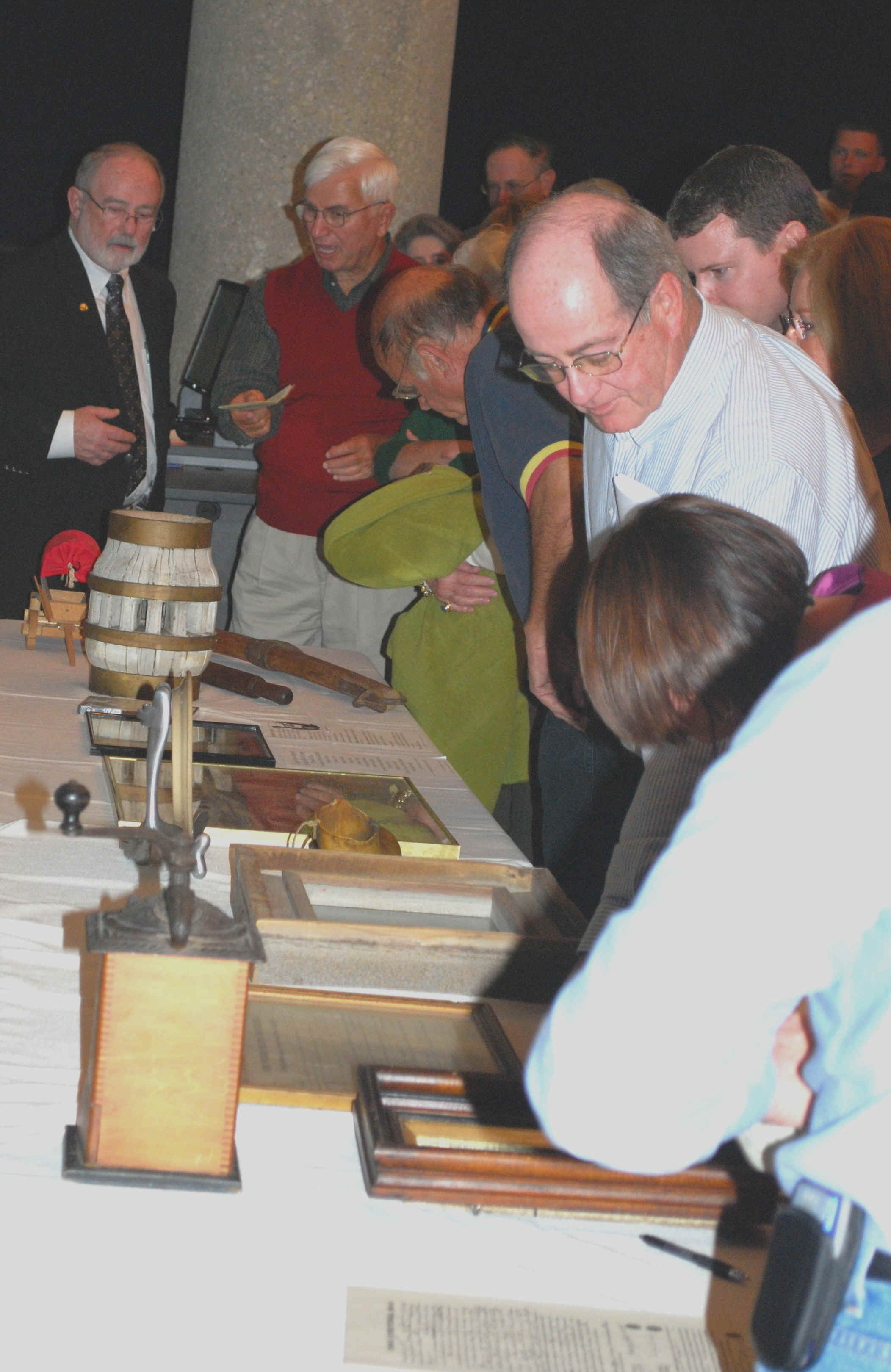 (posted
April 20, 2010)
(posted
April 20, 2010)
Donner Family Talk Draws SRO Crowd At UIS
Library
There wasn't
a seat to spare at the University of Illinois Brookens Library Auditorium
Tuesday evening, April 20, as an overflow crowd filled the room to hear Sangamon
County Historical Society board member Don Springer talk about the trials and
tribulations of the famed Donner Party.
Springer
is the great, great, great, great grandson of George Donner, who was chosen to
lead the wagon train over the final 1,000 mile portion of the historic journey
in which nearly half the party perished after becoming trapped in a winter
blizzard in the Sierra Mountains. George Donner and four other members of the
family were among the victims.
With his brother Bill and other descendents of the
Donner family in the audience that topped 220, Springer provided lesser known
details about the Donners prior to settling in Springfield. He also reflected on
the motivation behind their decision to leave Springfield in 1846, after 30
years of residence in Sangamon County. Springer also provided insight into the
hardships the wagon train faced in opting for an alternate route to California
that held promise for a shorter route but actually jeopardized the trip. After his talk, audience members (above, left)
had a chance to look at some of the documents and artifacts related to the
Donner Party. Springer (top left, in photo) and his brother have donated books,
reference materials, and memorabilia to the Library in an effort to make it a
full resource of Donner history for researchers, students, and others. The
Donner materials are usually housed in the Library's Archives and Special
Collections Department.
The
free program was co-sponsored with the Friends of Brookens Library and the
University's Engaged Citizenship Common Experience program. A reception followed
the presentation. If you missed Springer's presentation, you can watch it online
by
clicking
here.
(posted April 15, 2010)
Iles
House Draped in Bunting to Mark Mourning Days for Abraham Lincoln
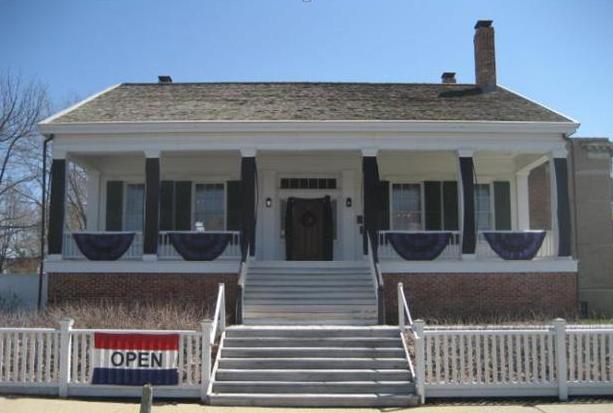
As was the custom at the time of Lincoln’s death, the front porch of
the Elijah Iles House in Springfield has been draped in bunting of black and
purple for the mourning period of President Abraham Lincoln’s death, April 15
through May 4.
One hundred and forty-five years ago, President Abraham
Lincoln’s funeral procession, after passing the Lincoln Home, proceeded along
Cook Street from Eighth to Fourth streets and would have passed on the north
side of the Iles House, then the Robert Irwin residence, when it was located at
its original site.
Elijah Iles served as one of the pall bearers on that
day of the burial services. The 69-year-old Iles walked the route to Oak Ridge
Cemetery as did the others on what was said to have been a very warm May day.
(posted April 11, 2010)
New Berlin Area Historical Society
Hosts April 18 Talk
by Taylor Pensoneau on "Gangsters of Southern Illinois"
"Gangsters of Southern Illinois" will be the topic of a Sunday
afternoon program of the New Berlin Area Historical Society scheduled for 2
p.m., April 18 at Capone's Hideout, 201 W. Illinois St., New Berlin. The event
is free and open to the public.
Southern Illinois historian and local author
Taylor Pensoneau will be speaking about The Shelton Gang and Black Charlie
Harris, notorious Pond Creek outlaws who dominated life in rural Wayne County
and other parts of the state from the 1920s to the early 1950s. All made
headlines throughout the nation, and Harris eventually landed on the FBI's 10
Most Wanted list.
Pensoneau of New Berlin is the author of six books,
including "Brothers Notorious: The Sheltons," " Dapper and Deadly
- The True Story of Black Charlie Harris," and "The Summer of
'50." These three books will be available for purchase as a fund-raising
event for the society.
The afternoon will provide a fun opportunity for all
history and gangster buffs to participate in a "Gangster and Pals
Rendezvous." In keeping with the theme, clothing from the Roaring 20s and
the 1930s will be worn, and vintage vehicles will be on display. Those attending
are encouraged to participate in the fun by dressing in vintage attire. Drinks
will be available, and light refreshments will be served.
Tickets can also be purchased in advance from
Capone's Hideout for a murder mystery dinner theatre following the afternoon's
event.
(posted March 16, 2010)
|
"How Illinois Became A State" Talk Draws Full House
|
(posted February
16,2010)
February 16 Audience Tops
100!
Railroad Historian's Power Point Show
Details
Rich History of Interurban Here

Railroad Historian
Dale Jenkins speaking to the Society on Tuesday, February 16.
More than 100 people
turned out for a Society-sponsored talk and power point show Tuesday, February
16 that traced the rise and fall of Illinois Traction System, once this area's
most popular commuter and freight rail service. The meeting was held at
the Lincoln Public Library in Springfield.
In
his opening remarks, railroad historian Dale Jenkins--who grew up about a block
from the Illinois Traction System’s Springfield terminal off Clear Lake Avenue--
recalled that as a very young child, he enjoyed watching the Interurban trains
go by. Then he discovered he could stop an oncoming train "just by sitting
on the tracks. " That prompted a visit from a railroad detective, Jenkins
said, who issued his mother a stern warning to keep her son away from the rails.
It
didn't work out that way.
After
high school, Jenkins joined the Illinois Traction System as a rail road police
officer, eventually succeeding the very railroad detective who admonished him as
a child.
Throughout
the hour-long presentation, the audience sat in rapt attention, occasionally
oohing and ahhing as Jenkins projected dozens of historic photos showing the
rich interiors of the passenger cars that took commuters back and forth between
cities, towns, and small villages across Central Illinois. He also showed photos
of passenger terminal buildings and rail lines that ran through Springfield as
well as a map of the route of a sister freight line that looped around the
outskirts of the city to avoid local regulations that would have otherwise
hampered its operations.
Passenger
service on the 550-mile electric interurban
rail line operated here from 1895 through the mid 1950s, bringing back memories
for some audience members who, in a question-and-answer session that followed
his talk, asked Jenkins about specific sites they remembered seeing as children
riding on the Interurban. That prompted Jenkins to show an additional set of
then and now photos, including one of a large garden at Starnes, where several
rail lines crossed. "They had gardens and walks, even a band," said
Jenkins, pointing to the spot now fenced and covered with underbrush that had
been remembered by the Interurban traveler.
In its heyday, the
interurban was the most convenient way to travel and ship freight at at time
when Central Illinois had dirt roads that disappeared in winter storms, turned
muddy in spring rain, and dusty in summer. But the growth in automobile
ownership and paved roads signaled the end of commuter service, Jenkins
explained. By
the time it ceased operations in 1981, it had become a completely diesel powered
freight-only service.
Jenkins,
who now lives in Decatur, worked for the line for 40 years, 37 of them as a rail
road police officer. He is founder and president of
the Illinois Traction Society, a group that is preserving the history of the
Illinois Terminal Railroad and its predecessor lines including the Illinois
Traction System and has also written a book about the line. He and
his wife Judy are volunteers at the Monticello Railway Museum which features
displays of rail cars and other equipment as well as steam-powered train rides
on weekends and holidays from May through October. Though he normally serves as
a conductor, Jenkins and his wife both hold engineer licenses.
On
behalf of the Sangamon County Historical Society, director and program committee
member Roger Whitaker presented Jenkins with a year's membership in the
organization.
(posted February 9, 2010)
Abraham Lincoln Funeral Train Monument Unveiled February 9
Station Ceremony Draws Crowd, Media, Despite Snow
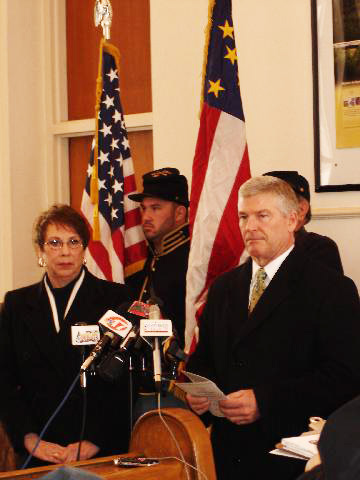
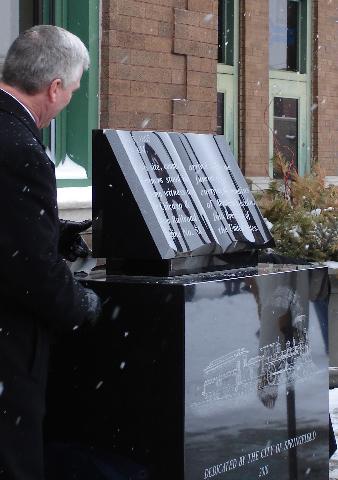
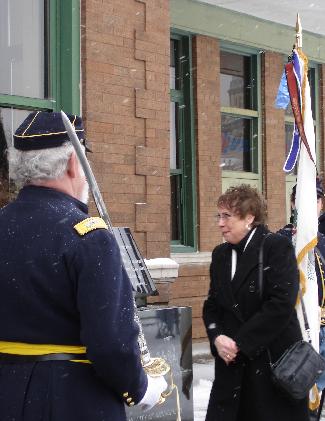

FROM LEFT: Spindell
listens as Mayor Davlin makes his remarks; Mayor Davlin looks at the
monument; Spindell gets a close up the honor guard fires
to the roll of the drums. BELOW: Local media were out in force to cover the
event.
An
unveiling ceremony for the
new Lincoln Funeral Train Memorial Monument at Springfield's Amtrak Station,
drew a large crowd of onlookers as well as the media Tuesday morning, February
9, despite snow that blanketed the area overnight and continued into the
day.
The site, on the west side
of the stationhouse at Third Street and Washington, marks the spot where the funeral train arrived in
Springfield on May 3, 1865, ending a 14-day, 1,700 mile journey from Washington,
D.C.
In a brief ceremony that started inside the
building, Springfield Mayor Tim Davlin praised Katie Spindell who drove the
effort to have some type of historic marker placed at
the  station that would show where the train made its final stop. Spindell
thanked the Mayor "for having enough faith in me and saying yes" to
the momument project.
station that would show where the train made its final stop. Spindell
thanked the Mayor "for having enough faith in me and saying yes" to
the momument project.
Another
speaker, James Cornelius, curator of the Abraham Lincoln Presidential Library
and Museum in Springfield, noted the relationship between Lincoln and railroads,
on which Lincoln frequently traveled. As a lawyer, Lincoln handled many cases
involving Illinois railroads, serving as both a prosecuting and defense
attorney, he said. As President, Lincoln recognized the importance of the
railroads to the Northern cause, creating the Military Rail Road in 1862 to
support the war effort. By the end of the Civil War, the United States had the
largest rail system in the world, he noted.
Led by two units of Civil War reenactment groups
in full uniform, the ceremony then moved outdoors where Mayor Davlin and
Spindell unveiled the monument followed by a ceremonial volley of rifle fire.
* * *
Spindell, a Sangamon County
Historical Society member, designed the three foot wide by five foot high black polished
granite monument that was assembled by Arnold Monument and includes an etched illustration of the Chicago & Alton rail-road
Engine 58 that pulled the funeral car from Union Station in Chicago to
Springfield. Engine 58 was draped with flags intertwined with crepe and bunting
and other symbols of mourning. Illinois artist Elizabeth Mattingly Thacker hand
etched the drawing onto the monument’s granite base.
Spindell, a member of the
board of the city’s International Visitors Commission, had for the past several years provided tourists and dignitaries with
information about Springfield. She frequently found herself being asked about
the location of the funeral train arrival site at what is now the Amtrak
station. "Over the years, thousands--and I do mean thousands--of tourists
asked me where the funeral train arrived and were disappointed to discover it
wasn’t designated with some type of monument or marker," said Spindell in
recent Historico interview.
The Lincoln Funeral Train
attracted some eight to 10 million mourners along its route from Washington D.C. through
Maryland, Pennsylvania, New York, Ohio, Indiana, and into Illinois. Markers and
memorials along the route can be found in every state.
Spindell, who spent
months researching the funeral train’s route, had sought a memorial that she
said would be "elegant, simple, dramatic, and somber." The monument
was installed at the site in December, awaiting for its unveiling.
Beaumont, Springer, Catlin Tapped as Directors for Society's Board
Three area residents have been appointed directors of the Sangamon
County Historical Society to fill vacancies on the board. They are James H.
Beaumont and Don Springer, both of Springfield, and Donna Catlin of
Sherman.
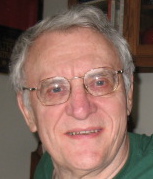 Beaumont, who retired as vice-president of the Illinois State Chamber of
Commerce in 2002, has long ties to this area. Born and raised in Decatur, his
father, James, was born and raised in Springfield in a house on Eighth Street,
south of the Lincoln Home.
Beaumont, who retired as vice-president of the Illinois State Chamber of
Commerce in 2002, has long ties to this area. Born and raised in Decatur, his
father, James, was born and raised in Springfield in a house on Eighth Street,
south of the Lincoln Home.
A graduate of Colgate University in
Hamilton, New York, Beaumont earned a master’s degree in journalism from
Columbia University in New York City, and a master’s degree in public
administration from the University of Illinois at Spring-field. Following
graduation from Columbia, Beaumont worked as a reporter for the daily Des
Moines Register, Iowa’s largest newspaper, the first of what
would be three separate vocations.
When a family friend’s job offer provided
an opportunity for him to move back to Decatur, he took it, even though it meant
switching careers and going back to school--to Northwestern--to receive training
as a stock-broker. Beaumont began his third career in 1972, this time as an
Illinois State Chamber of Commerce exec, moving to Springfield
with his wife, Mary, and children. Family members of the Society, today the
Beaumonts have two married sons and five grandchildren.
In 1994, he was named outstanding chamber
executive of the year by the Illinois Association of Chamber of Commerce
Executives. The award recognized long-term professional career achievements of
the candidate including experience, training and education, and service to IACCE
and other professional organizations.
A self-admitted history buff, he is particularly interested in the Civil War
Era, his desire to learn more piqued by a course he took at UIS taught by the
late Phillip S. Paludan, a leading authority on the life and presidency of
Abraham Lincoln. "I was fortunate to take Dr. Paludan’s course on the
Civil War Era as a senior learner at UIS the last time he taught it, and I’m
still reading books to follow up on topics raised in that class."
Beaumont will serve
as a director until 2012, filling what remains of a three year term vacated by
Bill Minder.
* * *
Springer, a descendant of the famed
Donner family of Springfield, whose ill-fated journey west 164 years ago, has
become an integral part of the history of America’s western migration, has
been a Life Member of the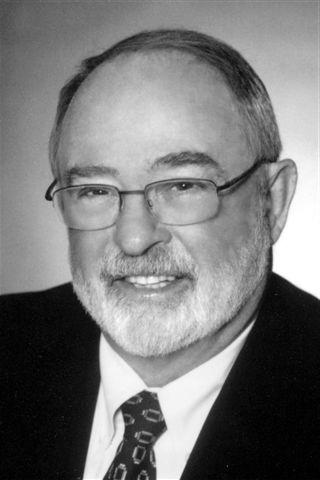 Society since 1966, serving on the board from 1998 to 2001.Abraham Lincoln lived
across the street from Springer’s great-great grand-father, the Reverend
Francis Springer, who founded both Trinity Lutheran and Grace Lutheran churches
in Springfield and was the city’s first superintendent of schools.
Society since 1966, serving on the board from 1998 to 2001.Abraham Lincoln lived
across the street from Springer’s great-great grand-father, the Reverend
Francis Springer, who founded both Trinity Lutheran and Grace Lutheran churches
in Springfield and was the city’s first superintendent of schools.
Springer will be
discussing the Donner Family’s Trials
of the Pioneer Trail, 1846 as guest speaker at the Society’s April
20 program meeting.
Springer is currently
a director of the Center for American Archeology and is a member of Sons of the
American Revolution. He is also a member of the American Business Club, the
Springfield Film Commission, and the University of Illinois Foundation. He and
his wife Karen have two children, a daughter, Paula. and a son, Douglas.
A financial advisor with Edward Jones,
Springfield, he has been in the field for 36 years and is a founder and charter
president of the Illinois Securities Industry Association. His hobbies include
travel, hunting, and bridge.
Springer will serve as a director until
2011, filling what remains of a two year term previously held by Jack Nevins.
* * *
 A native of Springfield, Catlin was raised in Sherman, attending local
schools there and in Williamsville before marrying in 1961 and moving to Normal,
Illinois.
A native of Springfield, Catlin was raised in Sherman, attending local
schools there and in Williamsville before marrying in 1961 and moving to Normal,
Illinois.
Before moving
back to Sherman 20 years ago, she and her husband Carl, a career Navy man,
traveled extensively around the world and lived in several states. But her love
of local and Sangamon County history never left, says Catlin.
When she returned
home, Catlin began what she describes as "my quest to find what history I
could for the growing village of Sherman," a time-consuming project. The
community’s village board and mayor have designated Catlin the honorary
"Sherman Historian."
Catlin will serve until 2012, completing
the three year term previously filled by Sarah Thomas.
Society
Gives Springfield, Pleasant Plains Schools Funds for History Projects
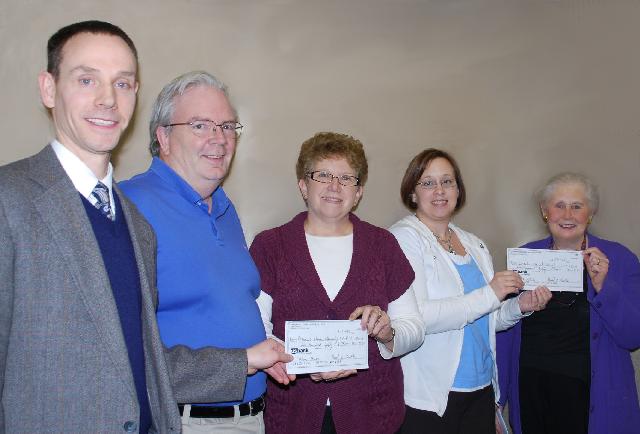
PROJECTS--ranging from buying books about Illinois and Sangamon County history for students at the Lincoln Magnet School to support their research for the Illinois History Fair to acquiring National Endowment for the Humanities reports on 19th Century Farming that will aid Pleasant Plains Elementary School sixth graders working on projects associated with the Pleasant Plains Historical Society’s restoration of the Clayville and Broadwell Inn--were awarded $250 grants from the Society to support their efforts. Checks were presented to teachers from each school at a special ceremony January 19 at the Chatham Public Library, held prior to the Society’s monthly program meeting. Society treasurer Paul Mueller (left) and Project Committee chair Elaine Birtch (right) share the moment with (from second left), Scott Morey, treasurer of the Pleasant Plains Historical Society, Pleasant Plains Sixth Grade Teacher Debbie Green, and Lincoln Magnet School teacher Jodi Mitts.
Contact the Sangamon County Historical Society
Phone: 217-522-2500 Email: schs@sancohis.org
All rights reserved. ©2010 Sangamon County Historical Society
